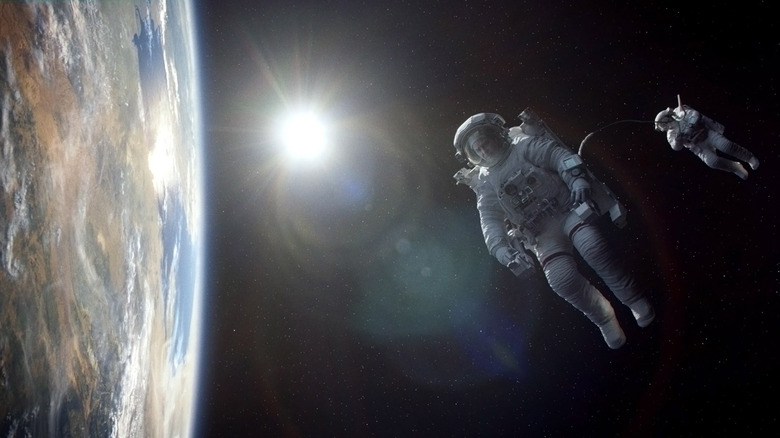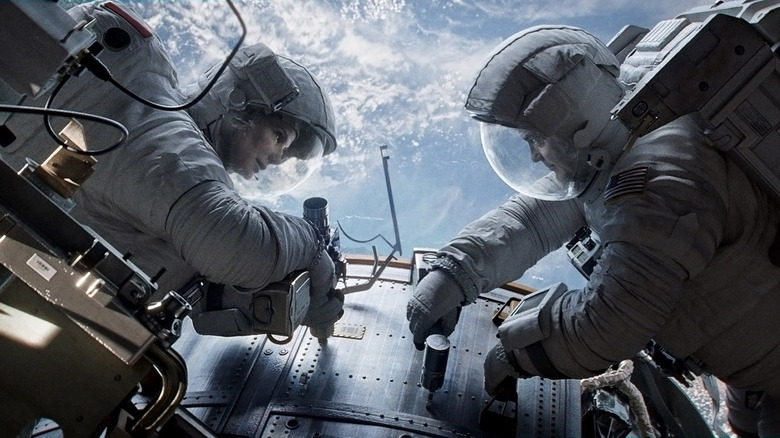Gravity's Crew Had To Get Creative To Make Sound Work In Space
In space, no one can hear your space station exploding into a million pieces in the nightmare scenario of humanity's increasingly crowded journey into the stars. The exact orbital physics and logistics that drive much of the action in director Alfonso Cuarón's "Gravity" may not be entirely up to NASA standards – don't take my word for it, but that of an actual astronaut! — but the filmmaker certainly went above and beyond to maintain as much scientific accuracy as he possibly could in his space-set 2013 masterpiece.
Of course, the creative team couldn't simply make an entirely silent film punctuated by the breathless radio calls of George Clooney's Matt Kowalski and Sandra Bullock's Ryan Stone. While it's true that no sound can travel through the vacuum of space, that doesn't necessarily mean that the unforgiving environment is fully devoid of our usual sensory experience here on the ground. In order to bring the stunning and immersive story to life, Cuarón and his immensely talented production crew had to go about finding innovative techniques in their pursuit of recreating what actual astronauts would encounter while on (debris-free) space walks outside the safe confines of the International Space Station.
In a behind-the-scenes video with THR, the acclaimed director spoke about putting the "audio" in "audiovisual storytelling":
"The sound in the storytelling of 'Gravity' is very important. There is no sound in space. So as you're in the vacuum, sound cannot be transmitted through the atmosphere. Nevertheless, sound is transmitted through interaction of elements. Meaning that if our characters grab, touch stuff, the vibration of that will travel into their ears. And so they will get a muffled representation of that sound."
Understanding that concept is the easy part, however. Next comes the complication of actually depicting that.
'He understood the science himself'
Despite nabbing a bounty of Oscar wins and nominations during the 2014 Academy Awards, somehow I'd argue that "Gravity" still doesn't receive its due credit for the monumental technical aspects (to say nothing of the brilliant script, also written by Cuarón along with his son, Jonás) that the creative team managed to pull off. Thankfully, re-recording mixer Skip Lievsay also lent his insights during that same video interview, explaining just how the director spearheaded the efforts to create some semblance of a soundscape in the dangerous beauty of space.
Heaping credit upon Cuarón for his strong vision of exactly how he wanted to bring this aspect to life, Lievsay had this to say about the process:
"He had a pretty iron-clad grip on what he thought the sound should be. He understood the science himself; because of they way he'd designed the movie, he was completely immersed in the suits and the shuttles, and what you could do and couldn't do, and how you would get from here to there if you just had a tether, or whatever the science happened to be. All the foley of everything they were doing — loosening the bolts, and moving things, and opening doors and everything — all came in the form of transducer recordings, which records vibrations rather than regular airborne audio. And really that whole layer of sound effects are those recordings."
Ultimately, knowing what you want out of the finished product as an artist is only half the battle. The other half involves the army of talented crew who are able to find (or even manufacture) ways to accomplish what the director wants. The final product speaks for itself, even outside the calibrated setting of a movie theater, and proves that "Gravity" has some serious staying power.

